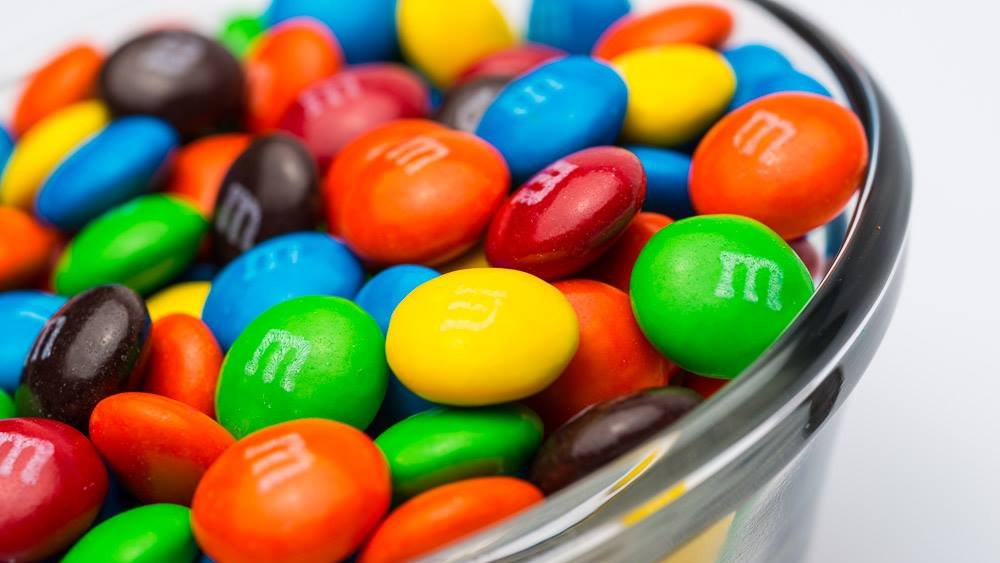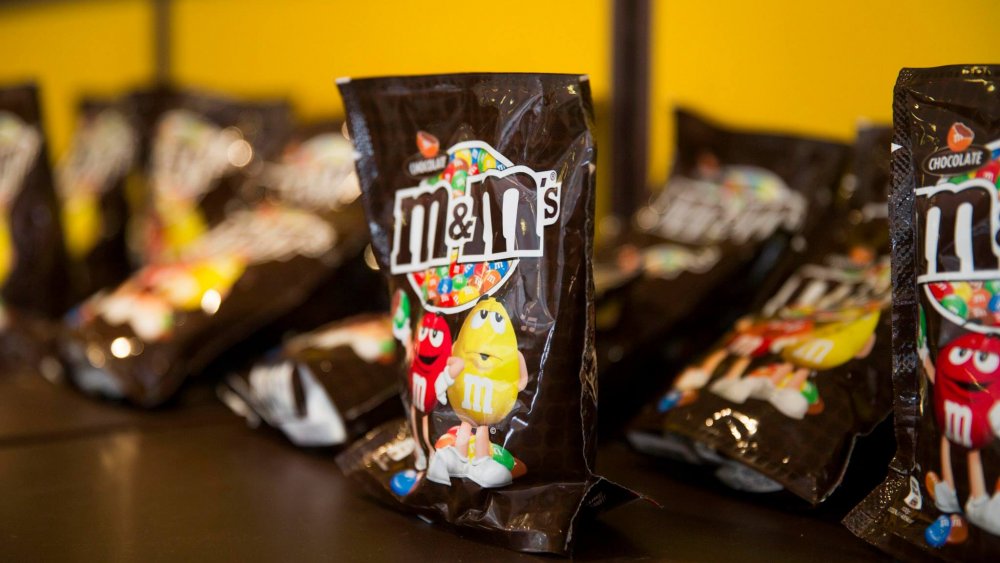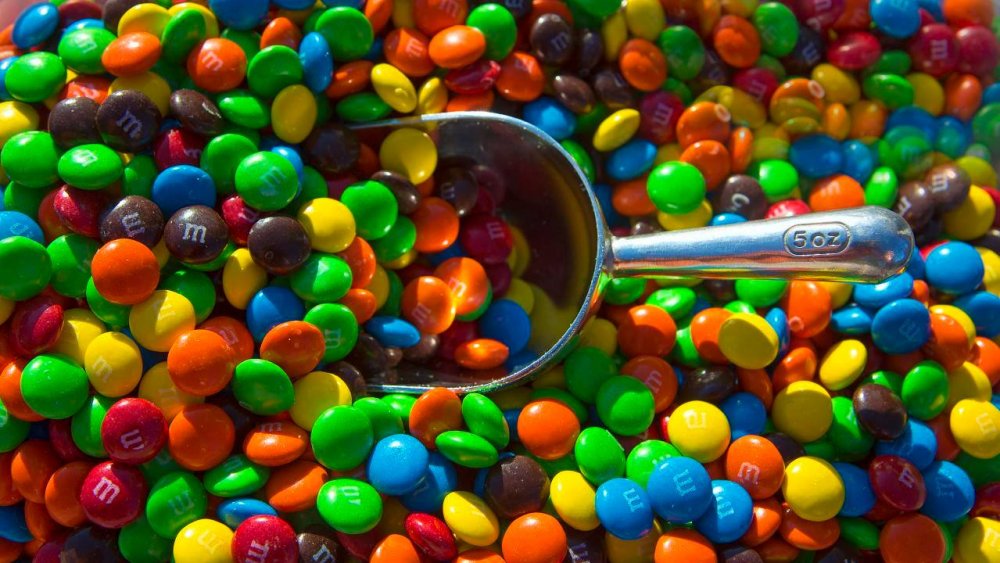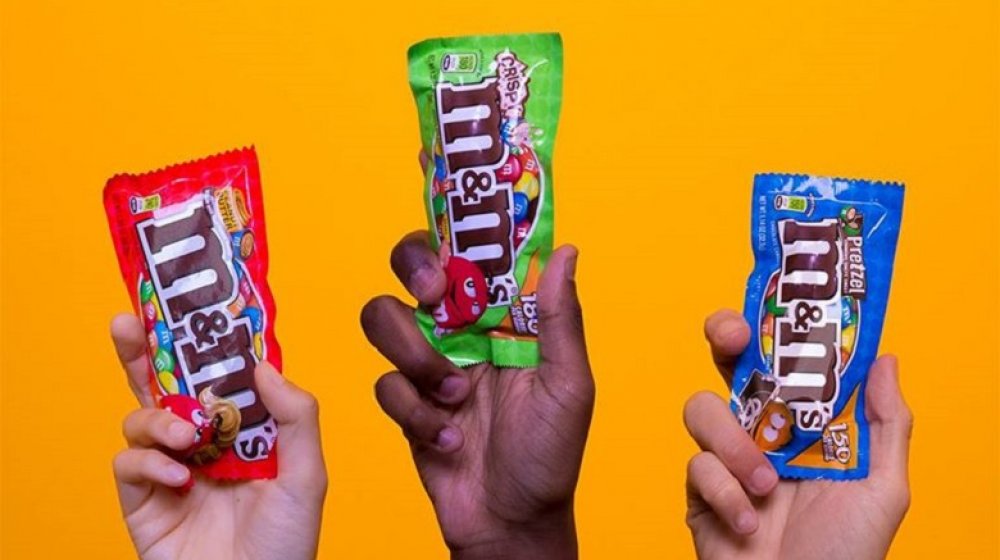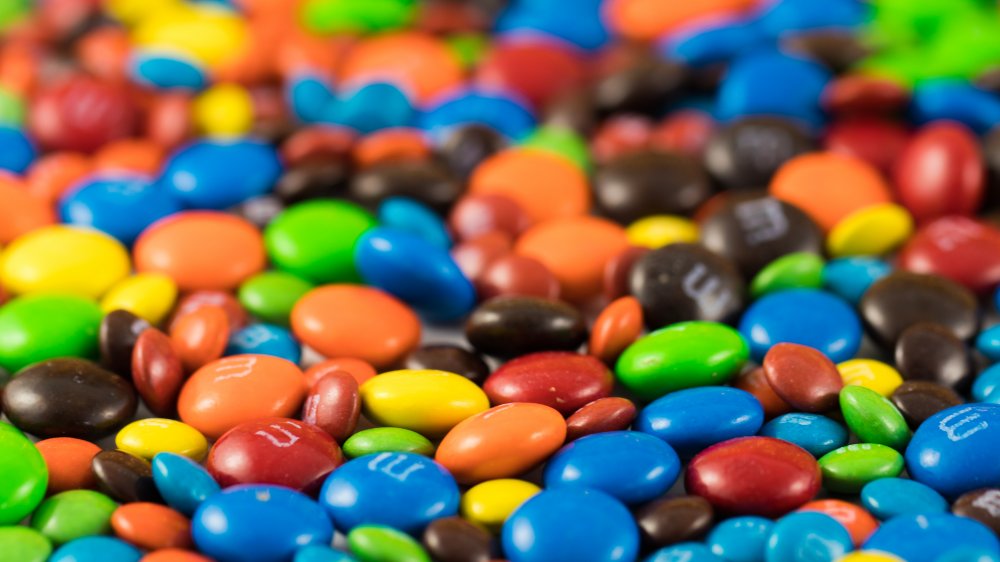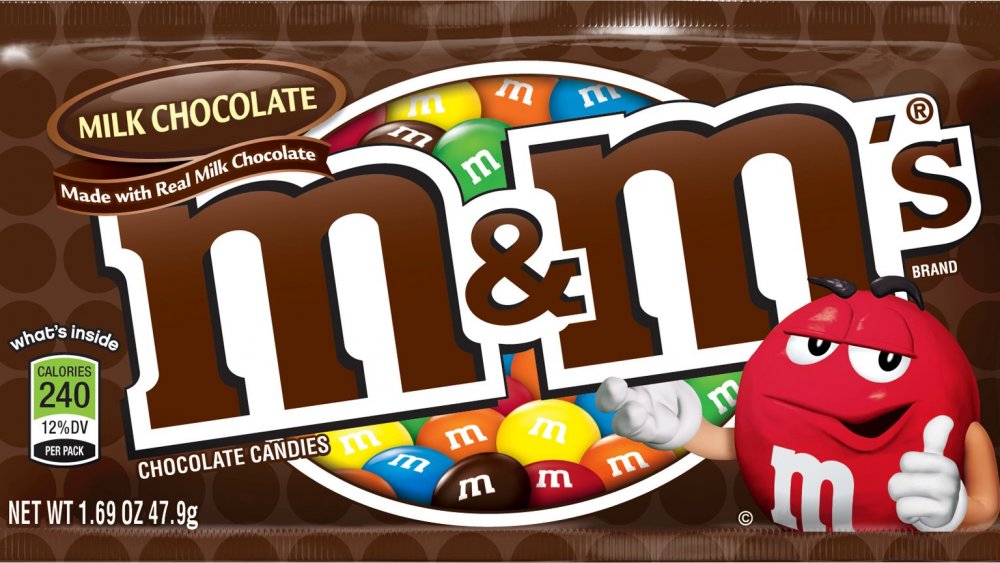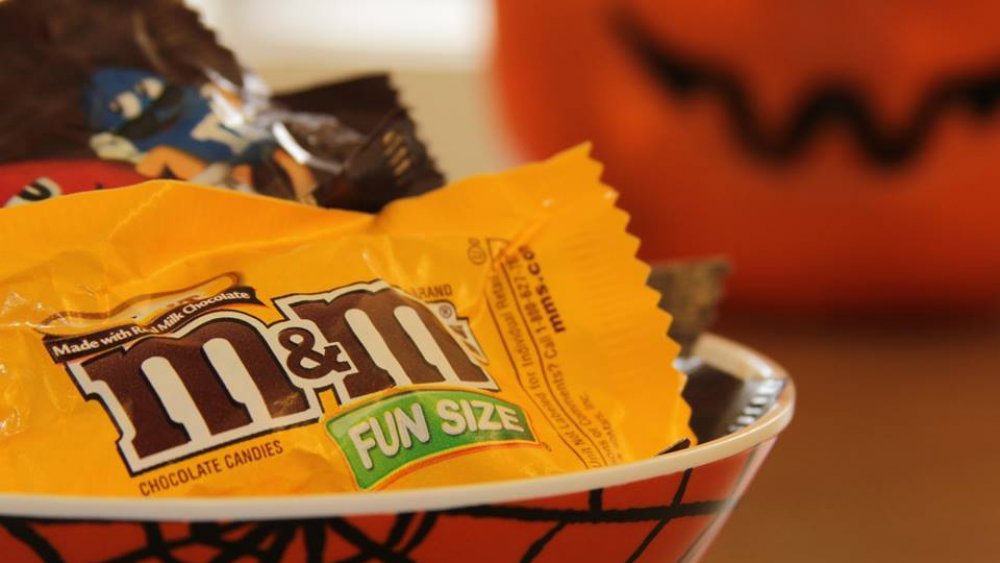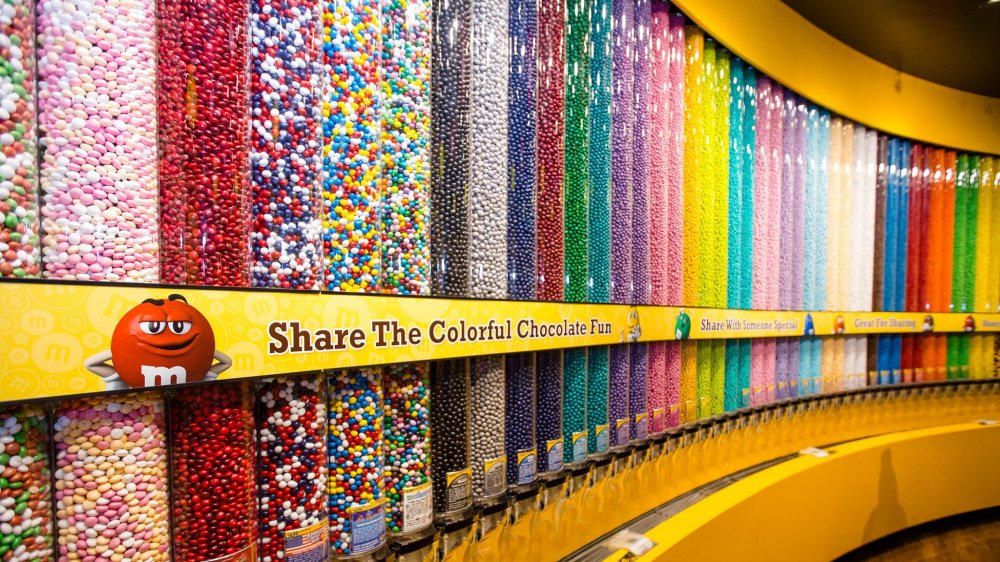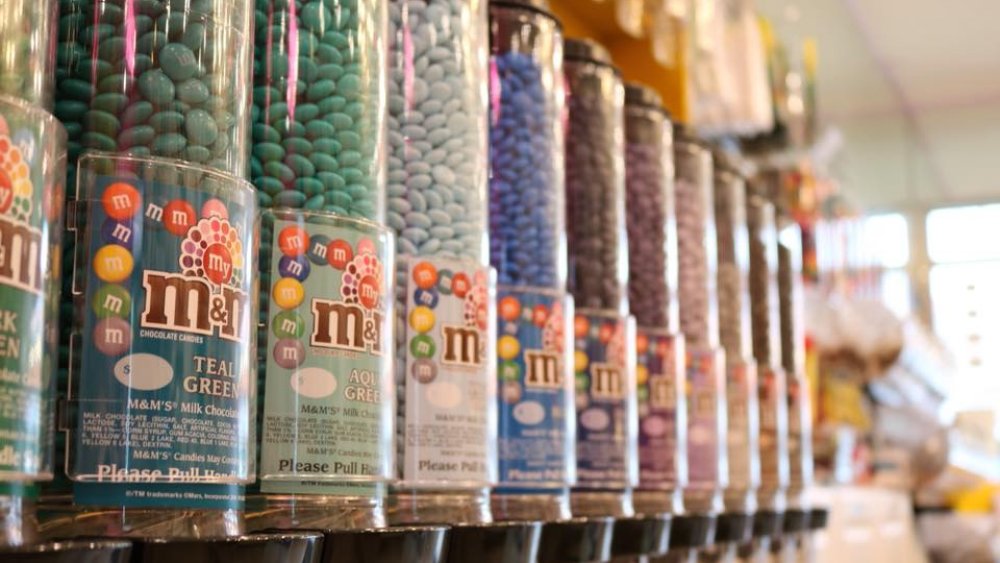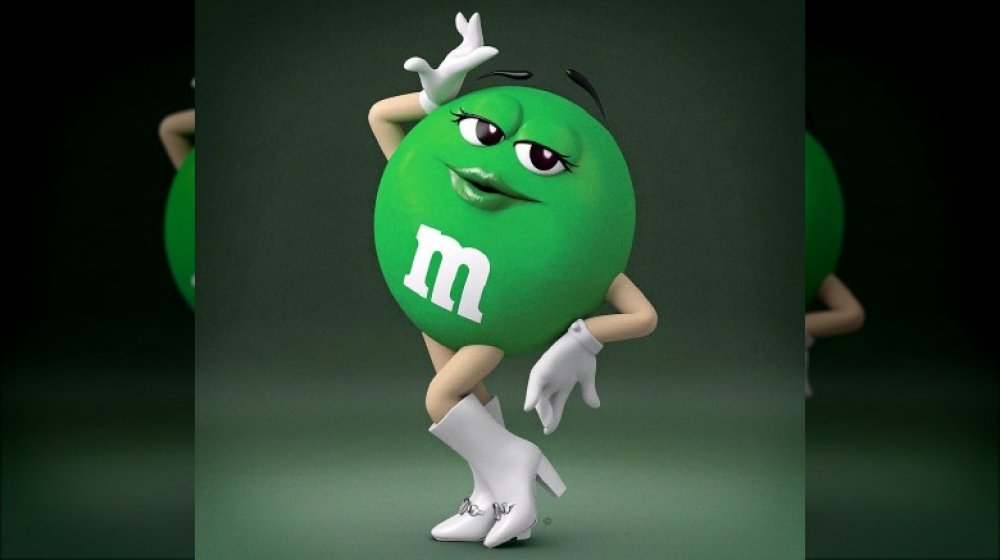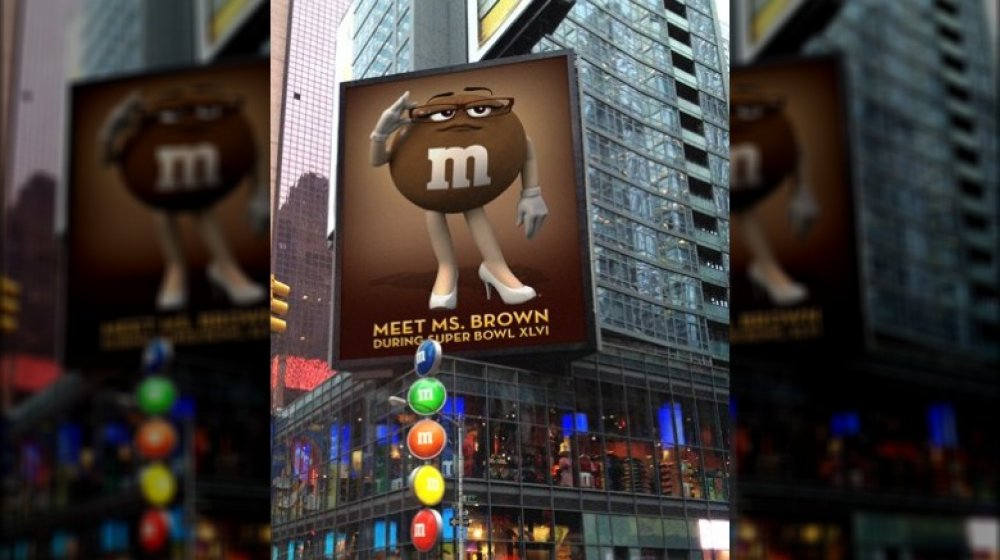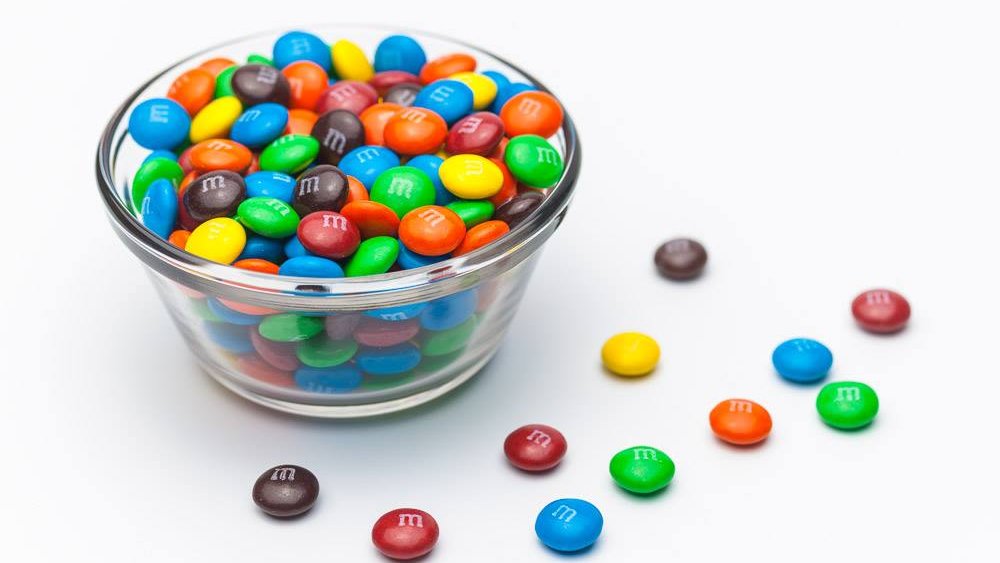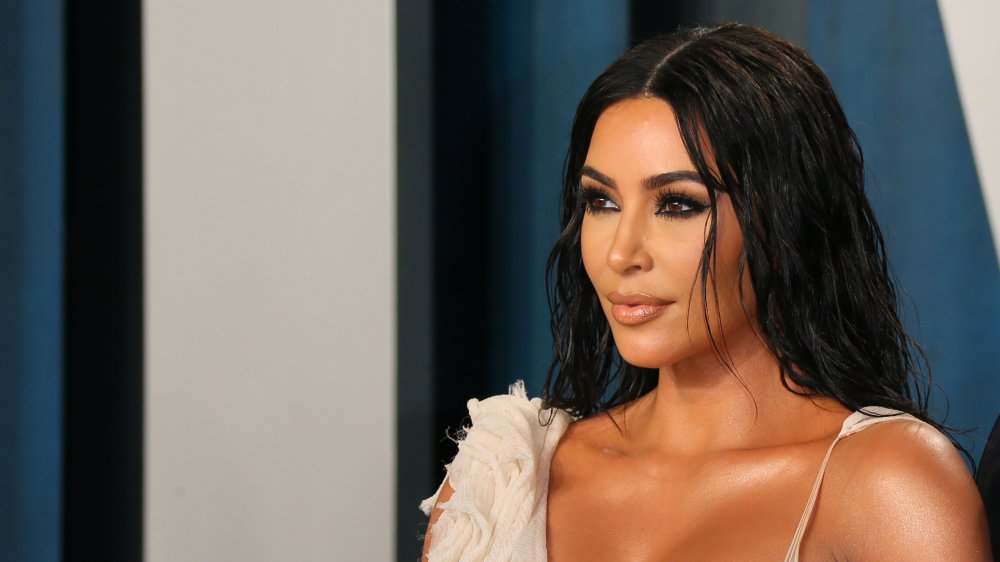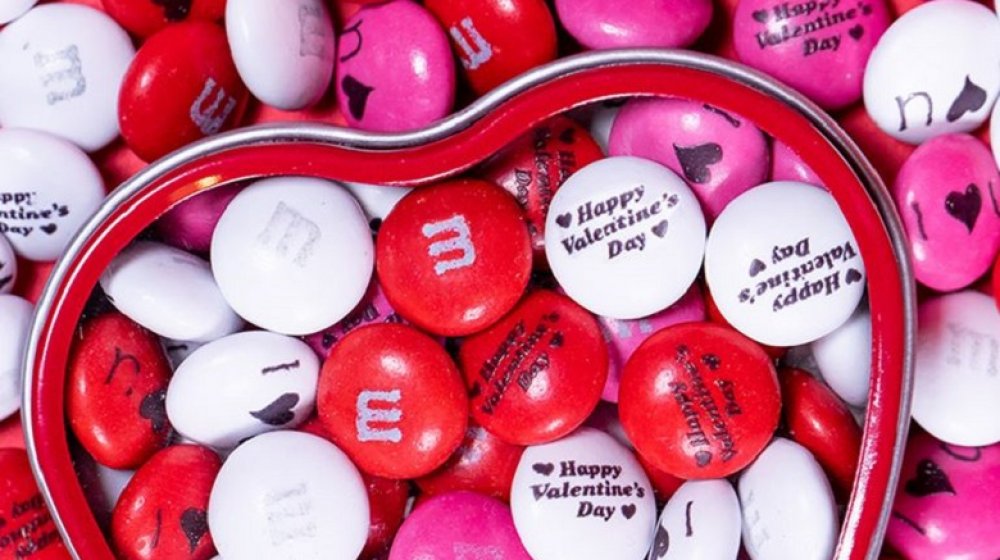The Untold Truth Of M&M's
With so many colors to choose from, along with a multitude of flavors, surely, there's a pack of M&M's for everyone. And it's pretty safe to say almost everyone has tried these little candy-coated confections at some point in their lives. Or, at the very least, you've been introduced to the Red and Yellow M&M's talking on your television.
M&M's have been through it all with us. From baking them in cookies, to using them on a dessert table at a wedding, to eating them by the handful on a hike, M&M's are truly a longtime candy staple. But just how long have M&M's been around? Where did the idea for M&M's come from, and really, how have they been so prominent in history? We decided to dig a little deeper into this confection's past to find out all about these delicious chocolate treats. This is the untold truth of M&M's.
M&M's have been around for decades
For most people, M&M's have been around for many of life's celebrations. Birthdays? Check. Halloween? Check. And that's all due to the longevity of the brand. M&M's were first introduced in the U.S. by Forrest E. Mars in Newark, New Jersey in 1941. But the inspiration goes back further than that.
Frank C. Mars had founded a candy business in Washington state in 1911, and then prepped his son, Forrest, to take on the job years later. As it turns out, Forrest wasn't too fond of how his father had been running his Washington candy company, and he had a new candy idea of his own. So, he sought out a business partner that might dive in on a joint venture — making candy-coated little chocolates.
Forrest Mars eventually paired up with Bruce Murrie, the son of William Murrie, president of Hershey's at the time, and the duo began making M&M's using Hershey's chocolate right at the beginning of the 1940s under their new company, Mars & Murrie. Mars ended up buying out Murrie entirely, taking Hershey's chocolate out of the picture and forming the company that makes M&M's, Twix, Snickers and more.
M&M's weren't available to the public at first
Although Mars and Murrie began making M&M's at the beginning of the 1940s, the candy-coated chocolates weren't actually distributed far and wide right off the bat. According to History, Mars had been inspired by soldiers he had seen eating candy-coated chocolates in England during the Spanish Civil War, and he moved back to the United States in hopes of replicating a candy-coated chocolate snack that wouldn't melt in the hands or pockets of soldiers.
A patent was granted for Mars to begin the manufacturing process, and he began creating the candies. The coated treats were packaged in a cardboard tube for easy transport and storage, and as the U.S. entered World War II, Mars sold his M&M's exclusively to the military to be included in soldier rations. It wasn't until the war ended that M&M's became available to the general public, and Mars introduced the paper brown package design in 1948 that we see on shelves today.
The colors and flavors of M&M's have expanded like crazy
A lot has changed in the decades since M&M's first came on the market. The original colors debuted with brown, red, orange, yellow, green, and violet, and the concept was simple — a little round of chocolate with a candy-coated shell. But since then that chocolate filling has morphed into so much more. In 1949, tan replaced violet, and then in 1995, blue ended up replacing tan. And Peanut M&M's, debuting in 1954, also went through a color change. According to Mental Floss, Peanut M&M's debuted as tan little candy pellets, only to later utilize the same colors of Original M&M's.
Original M&M's and Peanut M&M's were the only two flavors on the market for quite some time, until Peanut Butter M&M's debuted in 1989. Since then, more and more flavors have followed with the introduction of pretzel, mint, caramel, hazelnut, and more. There's even hot cocoa M&M's.
The 'm' stamped on each M&M candy was for a particular purpose
If you've ever stumbled upon Nestlé's Smarties, you may have realized they have quite a few things in common with M&M's. Typically, Smarties are only found in the UK, Canada, Germany, and Australia, but they've been around since 1937 — a few years before M&Ms hit the scene.
There certainly are some similarities between Smarties and M&M's, along with many other candy-coated chocolate confections. Both versions are produced in round, disk-shapes with bright, bold colors. And, as their claim to fame, neither Smarties nor M&M's will melt in your hands. But Mars didn't want there to be any confusion between his product compared to others.
According to M&M's History, Mars wanted a solution so that loyal customers could be sure they were eating real M&M's, rather than a different brand. So, each M&M began to receive an 'm' stamped on it in 1950. According to Mental Floss, the stamp color was originally black and switched to white in 1954, and has stuck with the candy ever since. At the time, the company created a slogan that said, "Look for the m on every piece."
The red M&M'S took a brief hiatus
The red M&M is a favorite of many — not to mention front and center on many of the package designs — but it hasn't always been that way.
While M&M's launched with red in its original color palette, the company halted the production of red M&M's in 1976 all thanks to the synthetic dye: Red No. 2. A Russian study in 1971 linked the red food dye to cancer, causing the U.S. Food and Drug Administration to dig into the commonly used dye a little deeper.
According to Live Science, the results didn't prove much when it came to human consumption, but because of its effects on rats, the FDA banned it. Funny enough, M&M's were never actually produced using Red No.2, but the company thought it would be best to avoid any confusion, pulling all red M&M's from production. Mars introduced orange at the time as a replacement, but eventually, the red M&M we all know and love came back in 1987 and has stuck with its pal yellow ever since.
M&M's went to space
There's only a handful of brands, and people for that matter, that can say they made it to space. M&M's is one of them, and the company has been able to brag about it for years.
According to M&M's history, the candy-coated chocolates were actually the first candy to be chosen to go to space in 1981. M&M's were chosen by the first space shuttle astronauts, adding them into their precious food supply.
But their presence has held strong since then. According to Smithsonian Magazine, M&M's is pretty common among NASA's space programs at this point because of their ease of packaging and consumption. But, M&M's have served another purpose for astronauts over the years as well: pure entertainment. According to Smithsonian Magazine, M&M's are sometimes released by the handfuls, allowing the pieces to float around in space. The game is for the astronauts to catch them with their mouths for the perfect entertaining snack.
Halloween takes a lot of prep for M&Ms
When it comes to Halloween in the U.S., it's all about the candy. And the amount of candy purchased for the spooky holiday is astounding. In 2019 alone, the National Retail Federation estimated $2.6 billion would be spent on Halloween candy, and M&M's make up a huge portion of that. According to CandyStore.com, M&M's rank third in the U.S. on the Halloween popularity scale, with Skittles and Reese's Cups just ahead of them, but that still means thousands of pounds of M&M's are being purchased and handed out to trick or treaters on an annual basis.
So how's a company to prepare for that? Luckily Mars has their plan down pat. According to CNN Business, Mars actually invests two years into preparing for Halloween. Employees are tasked with polling customers to see what they'd like for the holiday, recipes are tested, and then the marketing department gets to work to figure out packaging and displays that will really sell. Orders are placed months ahead of the holiday, with display plans in place, to be sure the mutually beneficial relationships between the candy company and its retailers are everything they can be.
There's a ridiculous amount of M&M's made and sold
Have you ever opened a bag of M&M's, eaten them by the handful, and then, oops, they're all gone. It's not terribly uncommon. With M&M's being small, they're the perfect snack to enjoy (or enjoy a little bit too much), and with so many people out there who love those little candy-coated chocolates, there are a whole lot of M&M's produced and sold.
According to CNN Money, after taking a tour through the M&M's factory in Hackettsville, New Jersey, close to 2 million M&M's are made every eight hours. That's a ton of M&Ms. But that's not the only factory producing these candies.
As of 2018, the factory in Cleveland, Tennessee was making 300 million M&M's every single day at the factory. And with that, 40 truckloads each day were leaving the factory to bring the product to stores across the U.S.
Mars once made a giant M&M's cow
There's a lot you can make with M&M's. They can be added to cookies instead of chocolate chips, thrown into a cake to add a pop of color in the center, or even used as a topping for pies, cupcakes, or sundaes. But Mars decided to get really creative and use M&M's to make a cow.
In 1990, the M&M's marketing team got creative, debuting a giant fiberglass cow decked out in M&M's. The cow featured 66,000 M&M's, all placed by hand with the 'm' logo facing outward. "Candy," the cow made her debut at the New York State's Erie County Fair as part of a milk chocolate promotional campaign, and Candy immediately soared in popularity. Visitors to the fair would wait 30 minutes in line just to see the giant candy cow, and it became the most popular attraction at the fair that year, not to mention the publicity gained by the cow being featured in Newsweek and a debut on Live with Regis and Kathie Lee.
The Green M&M's character has a pretty bold reputation
The M&M's characters have been around since 1995, showing up in ads and on commercials on a regular basis. But that fame wasn't always present. According to Business Insider, the candy brand's popularity was starting to flat-line, so Mars worked with a marketing agency to bring the brand to a new level. And the stars were born. Red, Yellow, Blue, and Green all debuted at that time, with Red, Yellow, and Blue taking on different male personas. And while the three male M&M's certainly are fun and have their own appeal, there's always been something about Green that people have loved the most.
Green was made to be a bit of a seductress, with her long lashes, her pouty lips, and her white go-go boots. And many have speculated that her persona was all due to rumors in the 1970s that green M&M's were an aphrodisiac. When Green debuted, M&M's used the rumors to their advantage to create a persona around the M&M's character, even utilizing the phrase, "Is it true what they say about the green ones?"
The second female M&M's character was introduced years later
Green has held the hearts of M&M's lovers for years, dating back to her debut in 1995. And at the time, she was the only female M&M's persona, surrounded by male M&M's. But in 2012, that all changed. Mars utilized the 2012 Super Bowl to make Brown's debut, showcasing her to over 110 million viewers. According to Time, the 30-second spot costs and average of $3.5 million during the Superbowl, and M&M's hadn't run an ad for three years prior to Brown making a big splash.
And just as the company did with each of the M&M's personas, Brown's addition came in a little package with a whole lot of personality. According to HuffPost, Brown debuted as the "Chief Chocolate Officer" finally revealing herself after years spent behind the scenes. Vanessa Williams, the voice behind Brown, told HuffPost that "Ms. Brown is definitely the brains behind it all. She's the one who introduced all of the other colored candies."
M&M's contain a whole lot of sugar
Let's face it, M&M's are pretty difficult to eat in moderation. Opening a bag and not eating the whole thing is, well, pretty much unheard of. But apparently Mars wants their customers to keep an eye on how much sugar they're consuming, even if it means less in sales for M&M's.
When the U.S. Department of Health released its 2015-2020 Dietary Guidelines, it noted a recommendation for Americans to limit their daily added sugar intake to no more than 10 percent of their overall caloric consumption for the day. According to CNN, Mars issued a statement in support saying that limited added sugar consumption would benefit all Mars consumers, in addition to better-informing shoppers with the added labels. Dave Crean, head of research and development at Mars at the time said, "We want people to enjoy Mars brands as part of a well-balanced diet."
A typical pack of M&M's actually weighs in with 29 grams of added sugar, or 58 percent of your daily value, so it's certainly over the recommended limit if you're eating the whole pack. Perhaps Mars doesn't expect a consumer to eat the whole pack in one day?
Kim Kardashian says microwaving M&M's is the secret of life
Kim Kardashian continues to take social media by storm, especially gaining attention for her skillfully taken selfies on Instagram and her makeup techniques. One might even say her workout routine and diet gets a lot of attention as well. But what about the way Kim Kardashian eats M&M's? Who would have thought that would gain so much attention.
In November 2019, Kim Kardashian shared on Instagram Stories and Twitter just how she eats her M&M's, and her followers went wild. Kardashian posted "Fun fact about me is I take M&M's and I heat them up in the microwave for 20 seconds so that inside they're hot and the chocolate is melty." The reality star said it was her "secret of life" sparking quite a bit of intrigue and some debate.
Even Today Show hosts Hoda and Jenna tried them to see just what everyone had been missing, along with thousands of social media followers. The jury's still out on whether it's life changing or not, but Kim K certainly showed people a new way to try these longtime candy confections.
You can get a completely custom version of M&M's
If you've ever thought it would be cool to have your face printed on an M&M, well, you can — and you can order them and have them shipped right to your door. Dan Michael, previous R&D Director for Mars came up with the idea and worked out all of the kinks, allowing people to, quite literally, order anything they wanted on their M&M's.
According to an interview with Atlas Obscura, Michael worked on the project for about six years before it came to fruition, launching an entirely new factory called The Print Shop to be able to produce the custom M&M's orders. Now, M&M's lovers can order just about anything they want printed on candy in any color. The M&M's shop offers 24 different colors to choose from, as well as the ability to add text, graphic images, or even upload a custom image.
